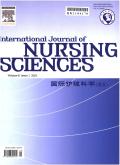技术护理干预对中老年血液透析患者营养状况的影响:系统综述
IF 3.1
3区 医学
Q1 NURSING
引用次数: 0
摘要
目的:营养不良在血液透析患者中很常见,增加了死亡率并显著影响生活质量。本研究旨在探讨技术护理干预,以促进中老年血液透析患者的自我照顾及改善其营养状况。方法按照Joanna Briggs Institute (JBI)和PRISMA指南进行系统的文献综述。在Medline、CINAHL、Cochrane图书馆、Scopus、Web of Science和灰色文献中进行了搜索。纳入了2018年至2024年间发表的研究,涉及40岁或以上接受定期血液透析的患者,并以葡萄牙语、英语或西班牙语提供。使用JBI的关键评估工具对文章进行严格的分析和方法学质量评估。结果738篇文献中,有10篇被纳入分析。建立了技术驱动的自我保健干预的五个关键维度。1)具有营养数据库、食物日志、个性化反馈等功能的移动应用和数字平台;2)利用社交媒体和聊天交流的电子学习和虚拟教育;3)远程护理采用面对面、电话和短信联系的混合随访模式;4)以营养状况为重点的教育策略,利用多学科团队的反教和图像学习等方法;5)综合评估工具评估治疗依从性(血液透析、药物、饮食、液体)和实验室标志物。据报道,几项结果均有显著改善:8项研究显示生化指标(如磷、钠、钾、钙、铁、白蛋白、尿素和血红蛋白)和营养状况得到改善,3项研究显示自我效能增加,2项研究报告改善了生活质量。结论将技术与面授教育相结合,可提高血液透析患者的营养状况,强调综合策略对提高治疗依从性和预防营养不良的重要性。本文章由计算机程序翻译,如有差异,请以英文原文为准。
Technological nursing interventions on nutritional status of middle-aged and older adults undergoing hemodialysis: A systematic review
Objective
Malnutrition is common in hemodialysis patients, increasing mortality and significantly impacting quality of life. This study aimed to identify technological nursing interventions that promote self-care and improve the nutritional status of middle-aged and older adults undergoing hemodialysis.
Methods
A systematic literature review was conducted in accordance with the Joanna Briggs Institute (JBI) and PRISMA guidelines. Searches were conducted in Medline, CINAHL, the Cochrane Library, Scopus, Web of Science, and grey literature. Studies published between 2018 and 2024, involving patients aged 40 years or more undergoing regular hemodialysis, and available in Portuguese, English, or Spanish, were included. JBI’s critical appraisal tools were used to conduct a rigorous analysis and methodological quality assessment of the articles.
Results
Out of a total of 738 articles, 10 were included for analysis. Five key dimensions of technology-driven self-care interventions were established. 1) Mobile applications and digital platforms with features like nutritional databases, food logging, and personalized feedback; 2) E-learning and virtual education using social media and chat-based communication; 3) Telenursing employing a hybrid follow-up model of face-to-face, telephone, and SMS contact; 4) Educational strategies focused on nutritional status, utilizing methods such as teach-back and pictorial learning within a multidisciplinary team; and 5) Comprehensive assessment tools evaluating treatment adherence (hemodialysis, medication, diet, fluid) and laboratory markers. Significant improvements were reported across several outcomes: eight studies showed enhanced biochemical markers (e.g., phosphorus, sodium, potassium, calcium, iron, albumin, urea, and hemoglobin) and nutritional status, three demonstrated increased self-efficacy, and two reported improved quality of life.
Conclusion
Integrating technology and face-to-face education enhances nutritional status, highlighting the importance of comprehensive strategies to improve treatment adherence and prevent malnutrition in hemodialysis patients.
求助全文
通过发布文献求助,成功后即可免费获取论文全文。
去求助
来源期刊

International Journal of Nursing Sciences
Nursing-Nursing (all)
CiteScore
6.10
自引率
2.60%
发文量
408
审稿时长
25 days
期刊介绍:
This journal aims to promote excellence in nursing and health care through the dissemination of the latest, evidence-based, peer-reviewed clinical information and original research, providing an international platform for exchanging knowledge, research findings and nursing practice experience. This journal covers a wide range of nursing topics such as advanced nursing practice, bio-psychosocial issues related to health, cultural perspectives, lifestyle change as a component of health promotion, chronic disease, including end-of-life care, family care giving. IJNSS publishes four issues per year in Jan/Apr/Jul/Oct. IJNSS intended readership includes practicing nurses in all spheres and at all levels who are committed to advancing practice and professional development on the basis of new knowledge and evidence; managers and senior members of the nursing; nurse educators and nursing students etc. IJNSS seeks to enrich insight into clinical need and the implications for nursing intervention and models of service delivery. Contributions are welcomed from other health professions on issues that have a direct impact on nursing practice.
 求助内容:
求助内容: 应助结果提醒方式:
应助结果提醒方式:


